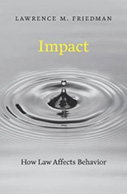Impact: How Law Affects Behavior

Author: Lawrence M. Friedman
Publisher: Cambridge, MA: Harvard University Press, 2016. 336p.
Reviewer: Christopher Slobogin | May 2017
Impact: How Law Affects Behavior, written by Stanford Law Professor Lawrence Friedman, is a very ambitious book. A dissection of the book’s subtitle illustrates the point. “Law,” of course, is a capacious term, even if confined to formal proclamations. It encompasses not just statutes and court decisions, but regulations, ordinances, agency manuals, and self-regulation by businesses. The “behavior” affected by a particular law (say, lowering the speed limit) can run the gamut from direct effects (less reckless driving) to indirect effects (fewer accidents) to very indirect effects (reduced economic efficiency resulting from slower cars) or very attenuated effects (a general resistance to government directives, caused by the perception that the legislature has enacted an unreasonable law or by police abuse of their new ticketing authority). Further, any study of a law’s impact might look not only at changes in the behavior of the law’s targets but also in the behavior of those who enforce the law (state trooper budgets and officer stress). Finally, establishing how law “affects” the wide varieties of behavior in which people engage is bedeviled by the usual difficulty in distinguishing causation from correlation (is a reduction in speeding due to the new speed limit law or the public’s knowledge about the accidents that triggered the speed limit law?) and figuring out the direction in which causation runs (did Brown v. Board of Education change racial attitudes or did Brown merely resonate with attitudinal changes already underway?).
Because its subject is so huge and complicated, the book can sometimes be frustrating, though through no fault of the author. Friedman looks at a wide range of subjects, from the deterrent effect of the death penalty to the impact of the Tarasoff decision on psychiatric treatment to the implications of Roe v. Wade. The goal, he says, is to come up with a “skeleton” or “hooks” that can help us think through how the law affects or might affect people, presumably with the hope of figuring out how we can improve our ability to realize the law’s objectives. In pursuit of that goal, the book describes, in a non-technical way that lay audiences will understand, dozens of studies from criminologists, economists, and other social scientists. The frustration comes from the fact that, time and again, Friedman’s conclusion is the same: no firm conclusions can be drawn, or if something definitive can be said, it is only in the specific context studied.
So, for instance, with respect to the criminal law, “We can maybe say some things about why some crimes occur at some times, or some places, or the impact of criminal justice systems here and there. . . . But to go further is a little bit like the task of predicting next year’s weather, or the next big earthquake; that is beyond our present capabilities” (pp. 136-37). Even when the focus is on more specific criminal law topics, the task of studying impact is daunting. As Friedman notes, the research on the deterrent effect of the death penalty suggests both that it saves lives and that it brutalizes them (pp. 118-120), and thus leaves us in stasis. With respect to research on the interrogation process, “it is hard enough to figure out the direct impact of a rule like Miranda; and, for the indirect impact, almost impossible” (p. 129).
The same is often true on the civil side. Whistle-blowing statutes can have some impact on uncovering corruption and illegality. But their efficacy is undermined by anti-snitching norms and the “crowding out” phenomenon, which posits that the mere fact of offering money to incentivize disclosure can have the opposite effect by sullying the moral value of one’s duty to uncover graft (pp. 142 & 224). Even Tom Tyler’s well-known and oft-cited conclusion, in Why People Obey the Law, that the legitimacy of law and legal authorities supersedes deterrence as an influence on conduct “goes way past what the evidence justifies,” according to Friedman (p. 193). As he says at the beginning of his last chapter, the results of these various types of behavioral studies “are often inconclusive”:
There are big gaps and holes in the research; but, more disturbingly, no consistency. The reader faces a volcanic eruption of research, but it hardly seems to be cumulative; it rarely adds up. Because of, or despite, the volume, the results leave the reader dizzy and bewildered, unsure of what she has learned (p. 248).
That is not to say, of course, that one learns nothing from the book. Friedman marshals evidence to support several common sense conclusions. First, without effective communication with the targeted group, the law will have no impact. Of most interest here, the effectiveness of the law’s messaging is often best achieved through subtle methods. Friedman describes how compliance can be improved through use of defaults (by requiring, for example, opting-out rather than opting-in), “cloverleafs” such as tax withholding (which, like a highway off-ramp’s effect on speed, forcefully push for desired behavior), and “nudges” (like telling hotel guests that everyone who has previously stayed in their room chose to reuse their towels). Second, building on the work of other scholars, Friedman recognizes and ably describes the three central ways behavior is influenced: punishment and rewards, peer pressure, and conscience. All three of these mechanisms can influence what Friedman calls the “deterrence curve”—the result of plotting an increase in a specific legal constraint (on the horizontal axis) against its effect on behavior (on the vertical axis). Friedman suggests that the optimal deterrence curve would slope downward. But he describes a number of conditions that could lead the curve to flatten out: when a moderate punishment is so effective that adding punishment is useless (think of criminal sentencing in America); when enforcement is non-existent or thought to be so; when peers strongly model opposing behavior; or when the targeted individuals (or businesses) are impulsive or psychopathic or, alternatively, convinced that the lawmaker’s goal is corrupt or immoral.
Friedman frankly admits that he prefers criminological and sociological research to the studies of economists, which he feels often are based on the assumption that humans are inherently rational actors. Even with that limitation, numerous motifs in the behavioral literature are unreported in the book. For instance, the book does not mention the phenomenon known as “moral credentialing,” which may lead people who have abided by one set of rules to feel entitled to disobey others. Friedman also ignores the concept of empirical desert, which hypothesizes that criminal sentences that adhere as closely as possible to citizens’ views of deserved punishment is the most efficient way of obtaining compliance with the law. The voluminous procedural and restorative justice literature—arguing that respectful treatment of people involved in the legal system will have huge behavioral payoffs—is barely mentioned. Also not explicitly contemplated is the possibility that, contrary to intuition, we don’t want downward-sloping deterrence curve, because some law violations may consist of socially productive activity that brings greater benefit than cost, or because punishing certain types of violators may bring more money or property into government coffers to aid overall enforcement efforts.
Of course, given the scope of the topic, these omissions are understandable and cannot even be called oversights. More troubling is the lack of infrastructure in some parts of the book. The first three chapters after the introduction, “Getting Out the Message,” “An Anatomy of Compliance,” and “A Typology of Responses,” consist of scores of examples without much glue to tie them together. The latter two chapters, while containing many interesting insights, are particularly difficult to situate within the project. One is hard put to discern in Chapter Three an anatomy of compliance with the law, or a typology of responses to the law in Chapter Four, or even how compliance with the law and the response to it differ from one another. To put it in Friedman’s terms, the “skeleton” doesn’t come through clearly in these chapters.
Later chapters that describe the punishment, peer and conscience models of behavior-influence are much easier to follow and provide a substantial contribution to understanding how law might affect human behavior. Because the peer and conscience models are not “law,” one might wonder why they are discussed in a work about law’s impact. But their treatment is crucial to the book. First, of course, both the norms of peer groups and the moral tenets of individual actors can be influenced by law. More importantly, both sources of behavior may also operate completely independently of law and even counteract it (think, for instance, of how gangs operate and of those who think abortion is a cardinal sin). To understand the impact of law, one has to understand countervailing, as well as bolstering, influences. In the penultimate chapter of the book, Friedman relies on a number of studies that nicely illustrate how the three models can interact and sometimes offset one another.
If the book does nothing else, it will persuade the reader that questions about how and why law affects behavior are complex and in need of much more research. The book also convinced me that conceptualizing this topic is an extremely difficult endeavor. One feature of Impact which initially bothered me was its repetitiveness. But redundancy is probably inevitable when writing about this topic, given the overlapping aspects of concepts such as “effective communication,” “optimal compliance,” and “direct and indirect impact.” I was hoping the last chapter would provide more concrete takeaway messages about how law can affect behavior. But, to his credit, Professor Friedman avoids reaching conclusions that are simply not borne out by the evidence. At the same time, the book begins to shape, if it does not outright create, an extremely important field of study.
Christopher Slobogin, J.D., LL.M., is the Milton Underwood Professor of Law at Vanderbilt University


